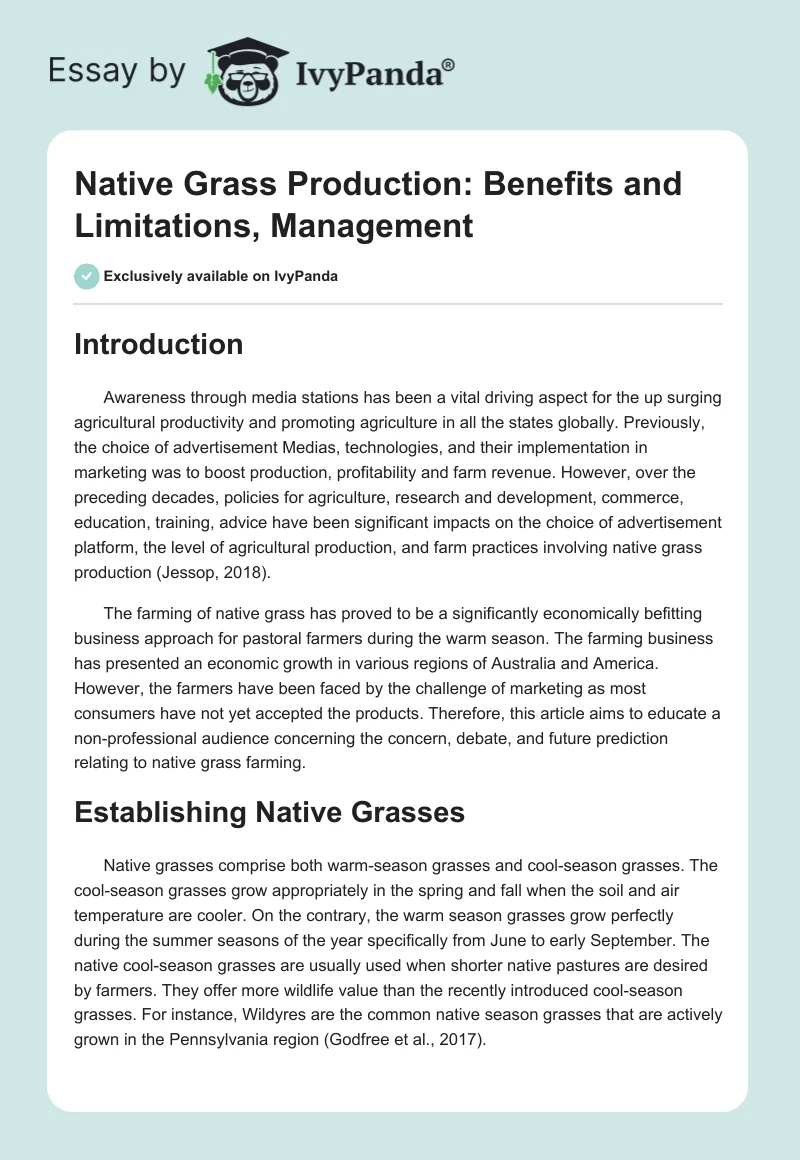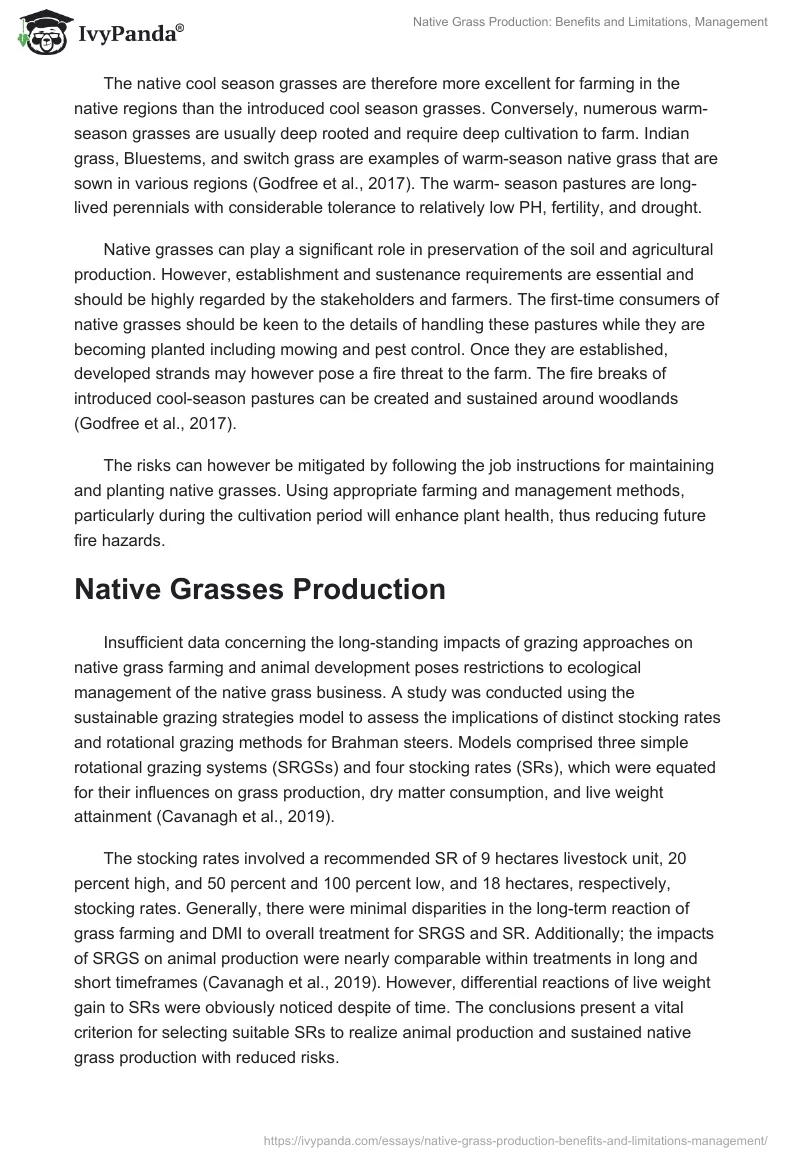Introduction
Awareness through media stations has been a vital driving aspect for the up surging agricultural productivity and promoting agriculture in all the states globally. Previously, the choice of advertisement Medias, technologies, and their implementation in marketing was to boost production, profitability and farm revenue. However, over the preceding decades, policies for agriculture, research and development, commerce, education, training, advice have been significant impacts on the choice of advertisement platform, the level of agricultural production, and farm practices involving native grass production (Jessop, 2018).
The farming of native grass has proved to be a significantly economically befitting business approach for pastoral farmers during the warm season. The farming business has presented an economic growth in various regions of Australia and America. However, the farmers have been faced by the challenge of marketing as most consumers have not yet accepted the products. Therefore, this article aims to educate a non-professional audience concerning the concern, debate, and future prediction relating to native grass farming.
Establishing Native Grasses
Native grasses comprise both warm-season grasses and cool-season grasses. The cool-season grasses grow appropriately in the spring and fall when the soil and air temperature are cooler. On the contrary, the warm season grasses grow perfectly during the summer seasons of the year specifically from June to early September. The native cool-season grasses are usually used when shorter native pastures are desired by farmers. They offer more wildlife value than the recently introduced cool-season grasses. For instance, Wildyres are the common native season grasses that are actively grown in the Pennsylvania region (Godfree et al., 2017).
The native cool season grasses are therefore more excellent for farming in the native regions than the introduced cool season grasses. Conversely, numerous warm-season grasses are usually deep rooted and require deep cultivation to farm. Indian grass, Bluestems, and switch grass are examples of warm-season native grass that are sown in various regions (Godfree et al., 2017). The warm- season pastures are long-lived perennials with considerable tolerance to relatively low PH, fertility, and drought.
Native grasses can play a significant role in preservation of the soil and agricultural production. However, establishment and sustenance requirements are essential and should be highly regarded by the stakeholders and farmers. The first-time consumers of native grasses should be keen to the details of handling these pastures while they are becoming planted including mowing and pest control. Once they are established, developed strands may however pose a fire threat to the farm. The fire breaks of introduced cool-season pastures can be created and sustained around woodlands (Godfree et al., 2017).
The risks can however be mitigated by following the job instructions for maintaining and planting native grasses. Using appropriate farming and management methods, particularly during the cultivation period will enhance plant health, thus reducing future fire hazards.
Native Grasses Production
Insufficient data concerning the long-standing impacts of grazing approaches on native grass farming and animal development poses restrictions to ecological management of the native grass business. A study was conducted using the sustainable grazing strategies model to assess the implications of distinct stocking rates and rotational grazing methods for Brahman steers. Models comprised three simple rotational grazing systems (SRGSs) and four stocking rates (SRs), which were equated for their influences on grass production, dry matter consumption, and live weight attainment (Cavanagh et al., 2019).
The stocking rates involved a recommended SR of 9 hectares livestock unit, 20 percent high, and 50 percent and 100 percent low, and 18 hectares, respectively, stocking rates. Generally, there were minimal disparities in the long-term reaction of grass farming and DMI to overall treatment for SRGS and SR. Additionally; the impacts of SRGS on animal production were nearly comparable within treatments in long and short timeframes (Cavanagh et al., 2019). However, differential reactions of live weight gain to SRs were obviously noticed despite of time. The conclusions present a vital criterion for selecting suitable SRs to realize animal production and sustained native grass production with reduced risks.
Benefits and Limitations of Native Grass Production
Grasses inhibit fibrous roots that are vital for supporting the soil particles which are prone to erosion. Furthermore, the grasses roots aid in developing organic matter in the soil and boost water infiltration. Native grasses have progressed to mature in a variety of environments including drought prone areas, low-nutrients soils, and seasonally flooded regions that makes them suitable for tough areas in both urban and rural zones (Jessop, 2018). Drought tolerant grasses, such as side-oats grama and blue grama can be cultivated in warm areas when they are exposed to the sun. Furthermore, the native grasses are suitable for native regions with strong winds as it will help in reducing soil erosion, thus preserving the soil from losing its fertility.
When consumers think about grasses, they frequently think about weeds, but several native pasture species present a delightful aesthetic in farms. They have varied shapes and elegant structures that offer beautiful sceneries despite being commercially viable. Furthermore, native grasses such as switch grass also create beautiful landscapes in the environment, thus sustaining the environment (Jessop, 2018).
The importance of these native pastures to the soil present more benefits to the environment despite their economic value to the farmers. Native grasses also offer habitat for native wildlife comprising insects and birds. Despite providing habitats being a key benefit of native pasture, the grasses usually host plants and specific species of butterflies during their larval stage. Furthermore, the native grasses offer numerous advantages to the natural environment, thus should be cultivated to promote both environmental and commercial benefits.
Considering the shifting climatic conditions in Australia, native grasses are suitable for the region since they are perennials and persist well despite the changes in environment (Jessop, 2018). Finally, native grass aid in regulating dry land salinity due to their deep root structures, summer activities and perenniality, minimizing recharge to ground water.
Despite the numerous benefits presented by the production, native pasture also have limitations. For instance, the wild species have varied genetic qualities, flower over long periods, have low seed yield that are not sufficient for commercial amounts for sustainable seeds. Moreover, native grasses are difficult to develop through cultivation with traditional farming methods. Some species of the native pasture are less consumable to stock since they have coarse hairy leaves and have lower nutritive value (Moore et al., 2019).
Finally, in situations where upgraded pasture classes perform effectively, native grasses are unlikely to be more productive and compete with improved pasture kinds. Therefore, considering the challenges presented by these grasses, farmers should focus on cultivating them solely and not mix them with the enhanced species. The native grasses also has numerous benefits compared to the new species and should therefore be introduced for both commercial and consumption purposes.
Overgrazing and its Impacts on Native Grasses Production
Overgrazing is instigated by grazing methods and behaviors of livestock that result in lower ground cover in vital regions of the landscape. It has posed a significant challenge in managing native grasses on steep lands where low ground cover regularly occurs on hill sides and crests especially during autumn and summer seasons. Overgrazing has an economic effect on native grass production as it reduces green pasture and stocking rates, while it impacts the environment through wind erosion, loss of biodiversity, and recharge (Cavanagh et al., 2019). Furthermore, when native grasses are set supplied, perennial classes are victims to discerning and substantial grazing. Overgrazing particularly on perennial native pastures, when they are overwhelmed by soil moisture, they can result to death of the native grass yields thus affecting the gross margin revenues of farmers.
The reduction in the population of perennial species in the native pastures will inspire the incursion other types of grasses, such as broadleaf weeds, onion grass, and annual grasses. The less consumable annual pastures are opportunistic species that develop when the soil water becomes accessible and complete their growth cycle within a short period (Cavanagh et al., 2019). These yearly pastures usually die and decompose during the autumn and summer seasons resulting to bare landscapes. Therefore, when these grass species are accepted as portion of the grassland over the cultivation season, native pasture production and nutritive value will be significantly impacted leading to reduced profits for the farmers.
Managing and Reviving Native Grasses
Despite the reduced market share and conception of native grasses amongst farmers, the production of these pastures can be restored through seedling recruitment and production of new native grasses. Similarly, they can be restored through increased maintenance and cultivation of the existing native pasture. Farmers, professionals, and stakeholders should further ensure there is establishment of significant competition of native pasture against other species.
However, such milestones can be realized through implementation of various strategies that will promote the inception of the practice. For instance, postponed grazing that resembles the schedule for grazing and resting of a pasture land to a suitable growth level of the needed fodder will offer positive selection pressure for the native grass classes (Jessop, 2018). Similarly, grazing substantially after yearly grass stem elongation, but prior to seed head emergence, preceded by the resting over the spring and summer season will boost the quantity of native grass seed yields, while minimizing the seeds from unwanted annuals.
Conclusion
In conclusion, the commercial production of native grasses has faced numerous challenges from market pressures influenced by lack of adequate information on the pastures. Stakeholders, farmers, and governments in regions that were initially active producers of native pasture have also been reluctant in enlightening the current market on such commercial farming thus leading to the decline of the industry’s presence.
However, with proper advertisements and promotions through social media platforms, television adverts, and endorsements, the native grass production can gain market presence thereby resulting to increased income for local farmers and the national governments. These milestones will be achieved as the non-specialist audience will now have an understanding of the industry. Moreover, native grass has numerous benefits to the environment and livestock especially during adverse seasons hence should be properly marketed to gain global appreciation.
References
Cavanagh, A. M., Godfree, R. C., & Morgan, J. W. (2019). An awn typology for Australian native grasses (Poaceae). Australian Journal of Botany, 67(4), 309–334. Web.
Godfree, R., Firn, J., Johnson, S., Knerr, N., Stol, J., & Doerr, V. (2017). Why non-native grasses pose a critical emerging threat to biodiversity conservation, habitat connectivity and agricultural production in multifunctional rural landscapes. Landscape Ecology, 32(6), 1219–1242.
Jessop, J. (2018). Grasses of South Australia: An illustrated guide to the native and naturalised species. Wakefield Press.
Moore, N. A., Camac, J. S., & Morgan, J. W. (2019). Effects of drought and fire on resprouting capacity of 52 temperate Australian perennial native grasses. New Phytologist, 221(3), 1424–1433. Web.


